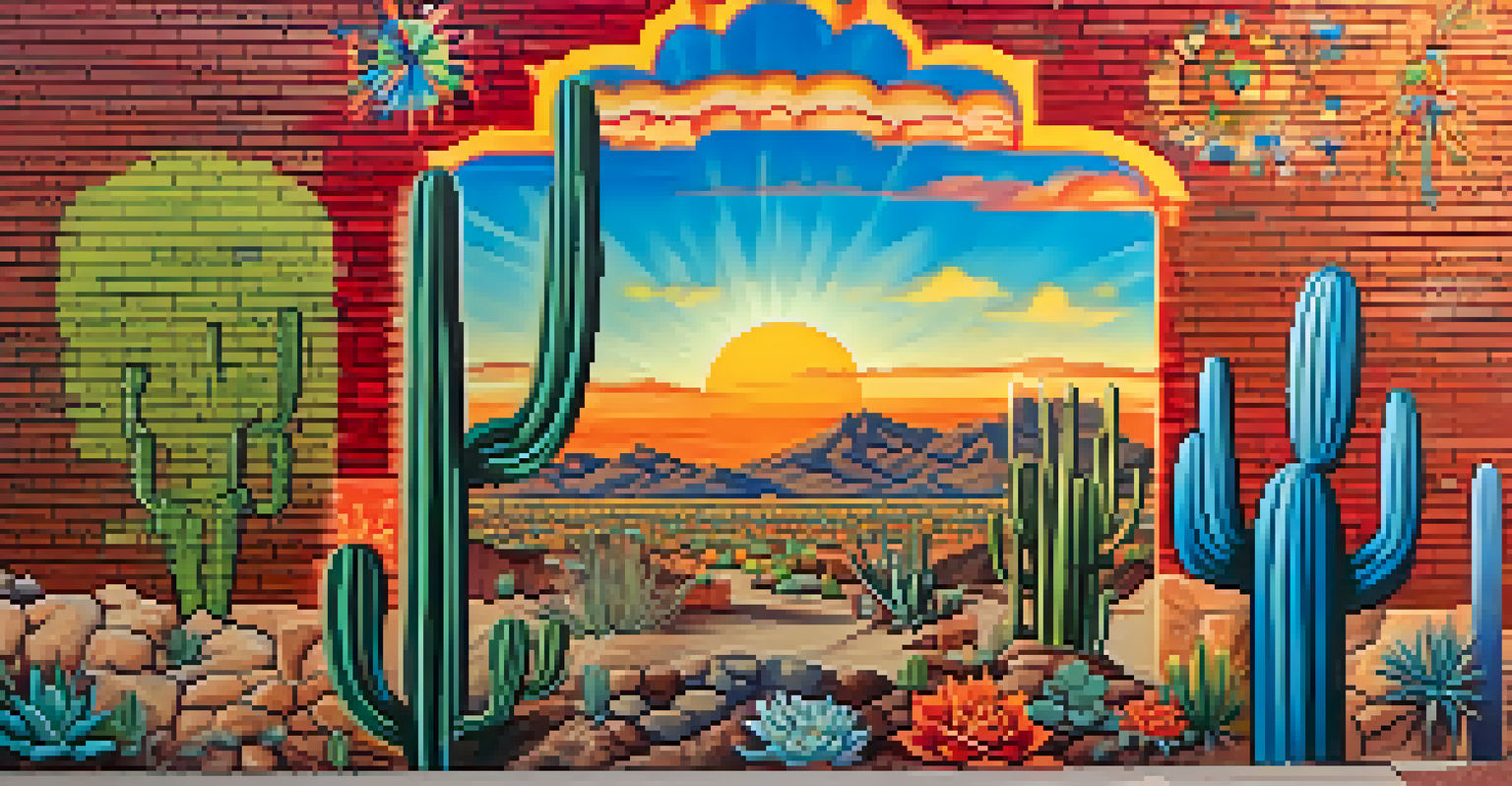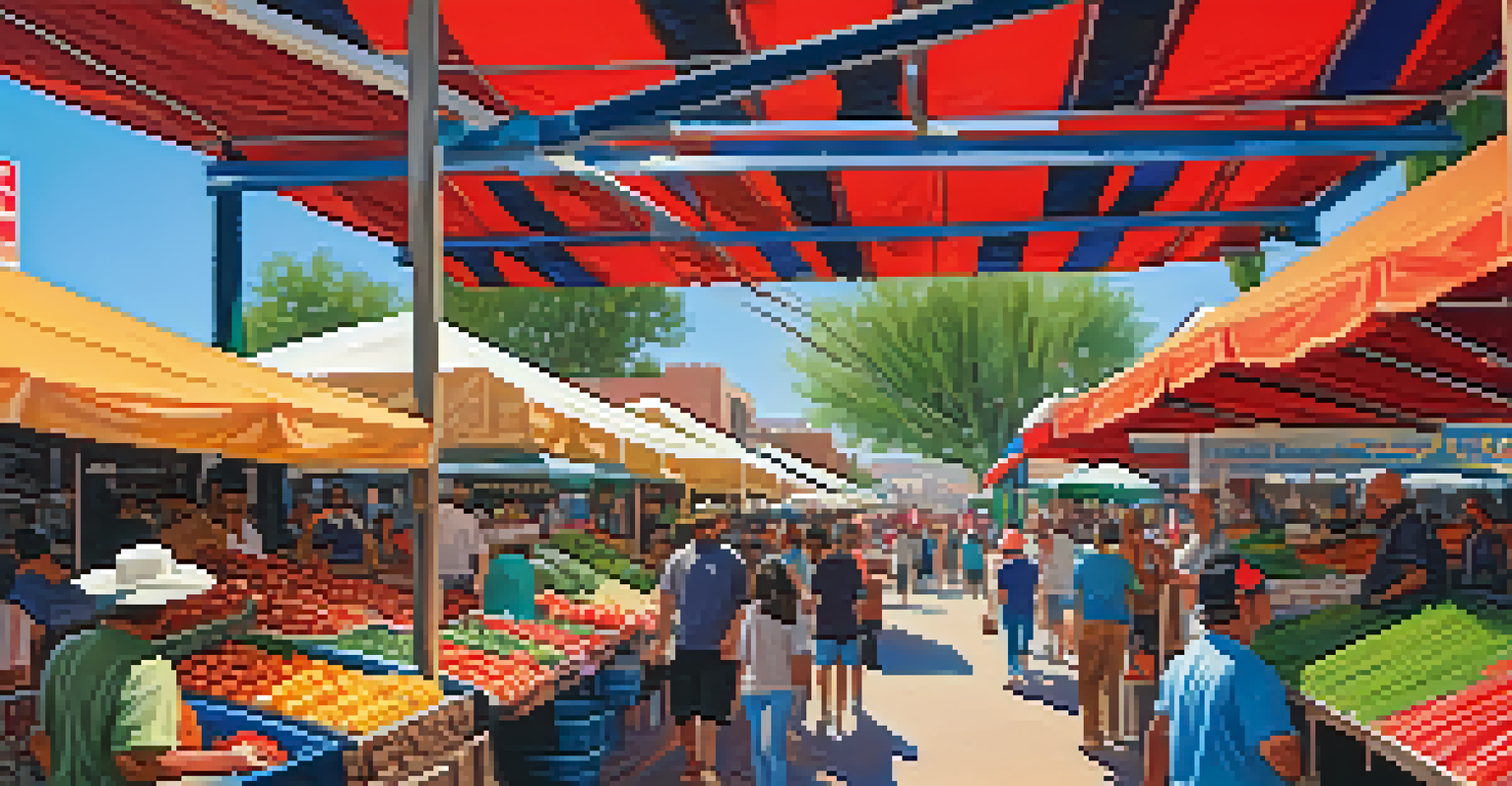The Impact of Immigration on Tucson's Local Culture

Tucson's Rich Cultural Melting Pot
Tucson’s culture is like a vibrant tapestry, woven from various threads of traditions. This city has been shaped by the influx of immigrants from Mexico, Central America, and beyond, each bringing unique customs and practices. For instance, the celebration of events like Dia de los Muertos has become integral to Tucson's identity, showcasing the fusion of local and immigrant influences.
Diversity is not a reason for division; it is a reason for celebration.
Many immigrants contribute to the local economy, not just through traditional jobs but also by introducing new businesses and flavors. Local markets and restaurants often reflect this diversity, offering everything from authentic street tacos to artisanal goods. This culinary evolution makes every dining experience an adventure, allowing residents and visitors alike to savor different cultures.
Furthermore, Tucson's art scene has thrived due to the diverse perspectives brought by immigrants. Local galleries and festivals often highlight the work of artists who draw inspiration from their heritage, creating a dynamic cultural exchange that enriches the community.
How Immigration Influences Local Festivals
Local festivals in Tucson have become vibrant showcases of the city’s rich cultural diversity. Events like Tucson Meet Yourself feature music, dance, and food from various immigrant communities, celebrating their contributions to the local culture. These festivals not only entertain but also educate attendees about the traditions and stories behind each culture.

Moreover, these gatherings foster a sense of community among residents and newcomers alike. They serve as platforms for building connections, where people from different backgrounds can come together and share their experiences. This exchange cultivates understanding and appreciation, bridging gaps that may exist due to cultural differences.
Tucson's Cultural Diversity Shines
The city's rich tapestry of cultures, influenced by immigrants, enhances its identity through traditions, cuisine, and art.
Ultimately, these festivals help preserve the identities of immigrant communities while integrating them into the broader Tucson culture. Through shared experiences, they contribute to a collective identity that honors both the past and the present, making Tucson a truly unique place to live and visit.
Education: A Cross-Cultural Exchange
Tucson's educational institutions have become hubs of cross-cultural exchange, thanks to its diverse population. Schools are increasingly incorporating multicultural curricula that reflect the backgrounds of their students. This approach not only enriches the learning environment but also prepares students for a globalized world.
Art is the most beautiful of all lies; it is a way to communicate emotions that transcend words.
Language programs in schools often include Spanish and Indigenous languages, which are vital for fostering communication with immigrant families. By encouraging bilingualism, schools help bridge cultural gaps and promote inclusivity. This, in turn, enhances students' cognitive skills and cultural awareness, making them more empathetic individuals.
Additionally, community organizations often collaborate with schools to provide resources and support for immigrant families. These partnerships create a network of assistance, ensuring that all children, regardless of their background, have access to quality education and opportunities for success.
Economic Contributions from Immigrant Communities
Immigrants play a crucial role in Tucson's economy, contributing to various sectors from agriculture to technology. Many local businesses are owned by immigrants, who bring innovative ideas and a strong work ethic. These entrepreneurs not only create jobs but also serve as role models for aspiring business owners in the community.
Moreover, the agricultural sector, vital to Tucson's economy, heavily relies on immigrant labor. Workers from different countries contribute to the cultivation of crops, ensuring that local markets thrive. This interdependence highlights the essential role immigrants play in keeping the economy robust and sustainable.
Festivals Foster Community Bonds
Local festivals celebrate cultural contributions, creating a platform for connection and understanding among diverse residents.
The economic impact of immigration extends beyond job creation; it also fosters cultural exchange through business practices and consumer preferences. As immigrant-owned businesses flourish, they introduce new goods and services, enhancing the local marketplace and making Tucson a more vibrant place to live.
Cultural Challenges and Resilience
While immigration enriches Tucson's culture, it also presents challenges related to integration and acceptance. Some long-time residents may feel threatened by the rapid changes in their community, leading to tensions that need to be addressed. Open dialogues and community initiatives are essential for fostering understanding and collaboration.
Despite these challenges, the resilience of immigrant communities shines through. Many engage in grassroots efforts to advocate for their rights and maintain their cultural heritage. This determination not only strengthens their communities but also contributes to the overall resilience of Tucson as a whole.
An example of this resilience is seen in cultural organizations that work to provide resources and support for immigrants. These organizations play a pivotal role in educating the public, promoting inclusivity, and celebrating diversity, helping to weave a stronger social fabric in Tucson.
The Role of Art in Cultural Integration
Art serves as a powerful medium for cultural integration in Tucson, allowing immigrants to express their experiences and perspectives. Public murals, performances, and exhibitions often reflect the stories of immigrant communities, inviting dialogue and understanding among diverse audiences. This artistic expression not only beautifies the city but also fosters a sense of belonging.
Community art projects frequently involve collaboration between local artists and immigrant groups, emphasizing shared experiences and collective identity. These initiatives not only create visually stunning pieces but also build bridges between cultures, highlighting common values and aspirations.
Education Bridges Cultural Gaps
Tucson's schools promote inclusivity and cultural awareness through multicultural curricula and language programs.
Additionally, art festivals in Tucson feature works from immigrant artists, showcasing their contributions to the local art scene. This recognition not only celebrates diversity but also encourages appreciation for the different narratives that shape Tucson's culture.
Looking Ahead: A Unified Cultural Future
As Tucson continues to evolve, the impact of immigration on its local culture will only become more pronounced. The city's ability to embrace diversity and foster inclusion will be key to its future success. By recognizing the value of immigrant contributions, Tucson can cultivate a community that thrives on collaboration and mutual respect.
Efforts to promote cultural understanding and support for immigrant communities will play a crucial role in shaping the city’s identity. Initiatives that encourage dialogue, support local businesses, and celebrate diversity will ensure that Tucson remains a welcoming place for all. This proactive approach will help mitigate potential conflicts and foster a harmonious community.

Ultimately, the future of Tucson lies in its ability to harness the strengths of its diverse population. By nurturing a culture of inclusivity and appreciation, Tucson can continue to grow as a vibrant, dynamic city that reflects the best of its residents, both new and old.